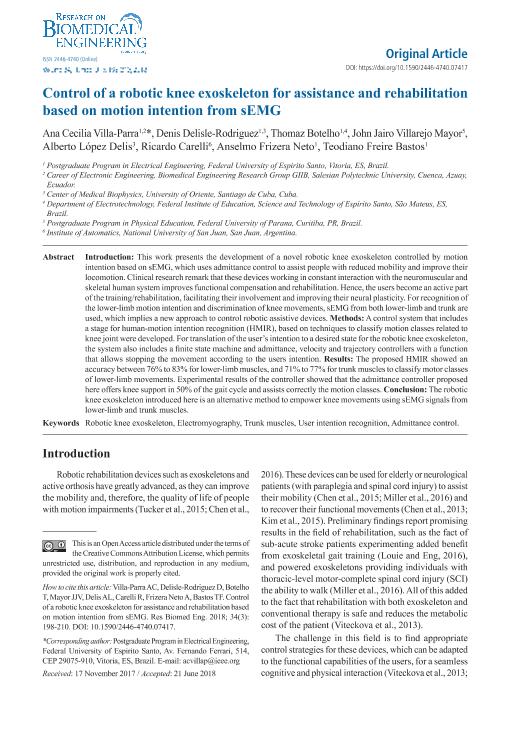Artículo
Control of a robotic knee exoskeleton for assistance and rehabilitation based on motion intention from sEMG
Villa Parra, Ana Cecilia; Delisle Rodriguez, Denis; Botelho, Thomaz; Mayor, John Jairo Villarejo; Delis, Alberto López; Carelli Albarracin, Ricardo Oscar ; Neto, Anselmo Frizera; Bastos, Teodiano Freire
; Neto, Anselmo Frizera; Bastos, Teodiano Freire
 ; Neto, Anselmo Frizera; Bastos, Teodiano Freire
; Neto, Anselmo Frizera; Bastos, Teodiano Freire
Fecha de publicación:
09/2018
Editorial:
Sociedade Brasileira de Engenharia Biomédica
Revista:
Research on Biomedical Engineering
ISSN:
2446-4732
e-ISSN:
2446-4740
Idioma:
Inglés
Tipo de recurso:
Artículo publicado
Clasificación temática:
Resumen
Introduction: This work presents the development of a novel robotic knee exoskeleton controlled by motion intention based on sEMG, which uses admittance control to assist people with reduced mobility and improve their locomotion. Clinical research remark that these devices working in constant interaction with the neuromuscular and skeletal human system improves functional compensation and rehabilitation. Hence, the users become an active part of the training/rehabilitation, facilitating their involvement and improving their neural plasticity. For recognition of the lower-limb motion intention and discrimination of knee movements, sEMG from both lower-limb and trunk are used, which implies a new approach to control robotic assistive devices. Methods: A control system that includes a stage for human-motion intention recognition (HMIR), based on techniques to classify motion classes related to knee joint were developed. For translation of the user’s intention to a desired state for the robotic knee exoskeleton, the system also includes a finite state machine and admittance, velocity and trajectory controllers with a function that allows stopping the movement according to the users intention. Results: The proposed HMIR showed an accuracy between 76% to 83% for lower-limb muscles, and 71% to 77% for trunk muscles to classify motor classes of lower-limb movements. Experimental results of the controller showed that the admittance controller proposed here offers knee support in 50% of the gait cycle and assists correctly the motion classes. Conclusion: The robotic knee exoskeleton introduced here is an alternative method to empower knee movements using sEMG signals from lower-limb and trunk muscles.
Archivos asociados
Licencia
Identificadores
Colecciones
Articulos(INAUT)
Articulos de INSTITUTO DE AUTOMATICA
Articulos de INSTITUTO DE AUTOMATICA
Citación
Villa Parra, Ana Cecilia; Delisle Rodriguez, Denis; Botelho, Thomaz; Mayor, John Jairo Villarejo; Delis, Alberto López; et al.; Control of a robotic knee exoskeleton for assistance and rehabilitation based on motion intention from sEMG; Sociedade Brasileira de Engenharia Biomédica; Research on Biomedical Engineering; 34; 3; 9-2018; 198-210
Compartir
Altmétricas



